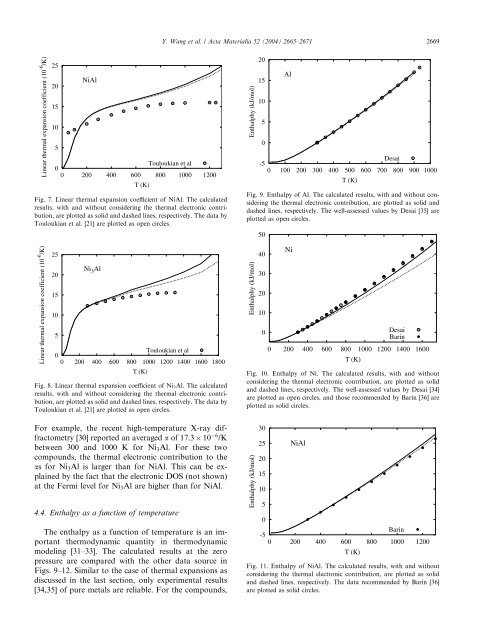Thermodynamic properties of Al, Ni, NiAl, and Ni3Al from first ...
Thermodynamic properties of Al, Ni, NiAl, and Ni3Al from first ...
Thermodynamic properties of Al, Ni, NiAl, and Ni3Al from first ...
Create successful ePaper yourself
Turn your PDF publications into a flip-book with our unique Google optimized e-Paper software.
Y. Wang et al. / Acta Materialia 52 (2004) 2665–2671 2669<br />
Fig. 7. Linear thermal expansion coefficient <strong>of</strong> <strong>Ni</strong><strong>Al</strong>. The calculated<br />
results, with <strong>and</strong> without considering the thermal electronic contribution,<br />
are plotted as solid <strong>and</strong> dashed lines, respectively. The data by<br />
Touloukian et al. [21] are plotted as open circles.<br />
Fig. 9. Enthalpy <strong>of</strong> <strong>Al</strong>. The calculated results, with <strong>and</strong> without considering<br />
the thermal electronic contribution, are plotted as solid <strong>and</strong><br />
dashed lines, respectively. The well-assessed values by Desai [35] are<br />
plotted as open circles.<br />
Fig. 8. Linear thermal expansion coefficient <strong>of</strong> <strong>Ni</strong> 3 <strong>Al</strong>. The calculated<br />
results, with <strong>and</strong> without considering the thermal electronic contribution,<br />
are plotted as solid <strong>and</strong> dashed lines, respectively. The data by<br />
Touloukian et al. [21] are plotted as open circles.<br />
Fig. 10. Enthalpy <strong>of</strong> <strong>Ni</strong>. The calculated results, with <strong>and</strong> without<br />
considering the thermal electronic contribution, are plotted as solid<br />
<strong>and</strong> dashed lines, respectively. The well-assessed values by Desai [34]<br />
are plotted as open circles, <strong>and</strong> those recommended by Barin [36] are<br />
plotted as solid circles.<br />
For example, the recent high-temperature X-ray diffractometry<br />
[30] reported an averaged a <strong>of</strong> 17.3 10 6 /K<br />
between 300 <strong>and</strong> 1000 K for <strong>Ni</strong> 3 <strong>Al</strong>. For these two<br />
compounds, the thermal electronic contribution to the<br />
as for <strong>Ni</strong> 3 <strong>Al</strong> is larger than for <strong>Ni</strong><strong>Al</strong>. This can be explained<br />
by the fact that the electronic DOS (not shown)<br />
at the Fermi level for <strong>Ni</strong> 3 <strong>Al</strong> are higher than for <strong>Ni</strong><strong>Al</strong>.<br />
4.4. Enthalpy as a function <strong>of</strong> temperature<br />
The enthalpy as a function <strong>of</strong> temperature is an important<br />
thermodynamic quantity in thermodynamic<br />
modeling [31–33]. The calculated results at the zero<br />
pressure are compared with the other data source in<br />
Figs. 9–12. Similar to the case <strong>of</strong> thermal expansions as<br />
discussed in the last section, only experimental results<br />
[34,35] <strong>of</strong> pure metals are reliable. For the compounds,<br />
Fig. 11. Enthalpy <strong>of</strong> <strong>Ni</strong><strong>Al</strong>. The calculated results, with <strong>and</strong> without<br />
considering the thermal electronic contribution, are plotted as solid<br />
<strong>and</strong> dashed lines, respectively. The data recommended by Barin [36]<br />
are plotted as solid circles.
















